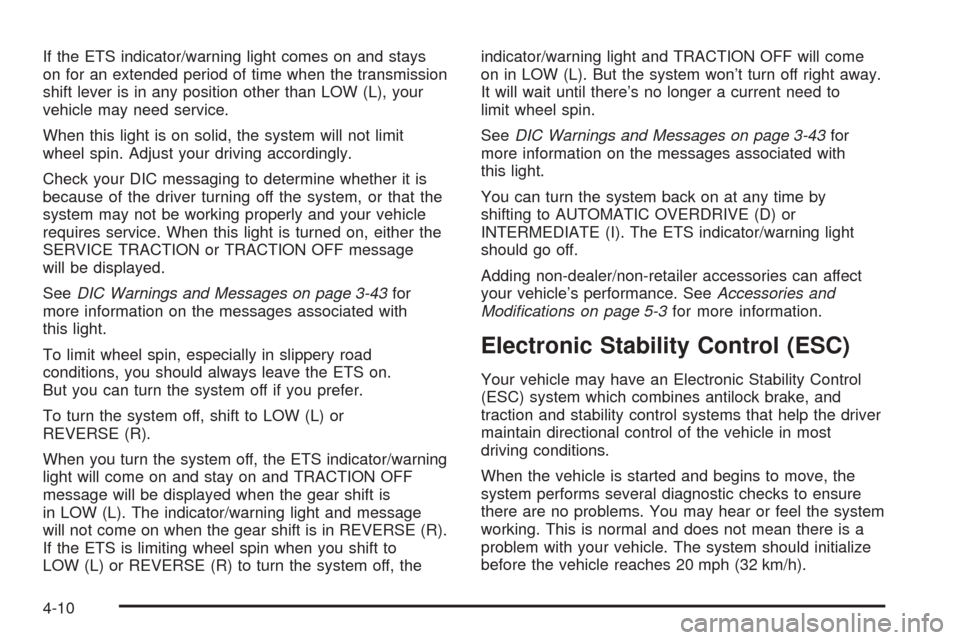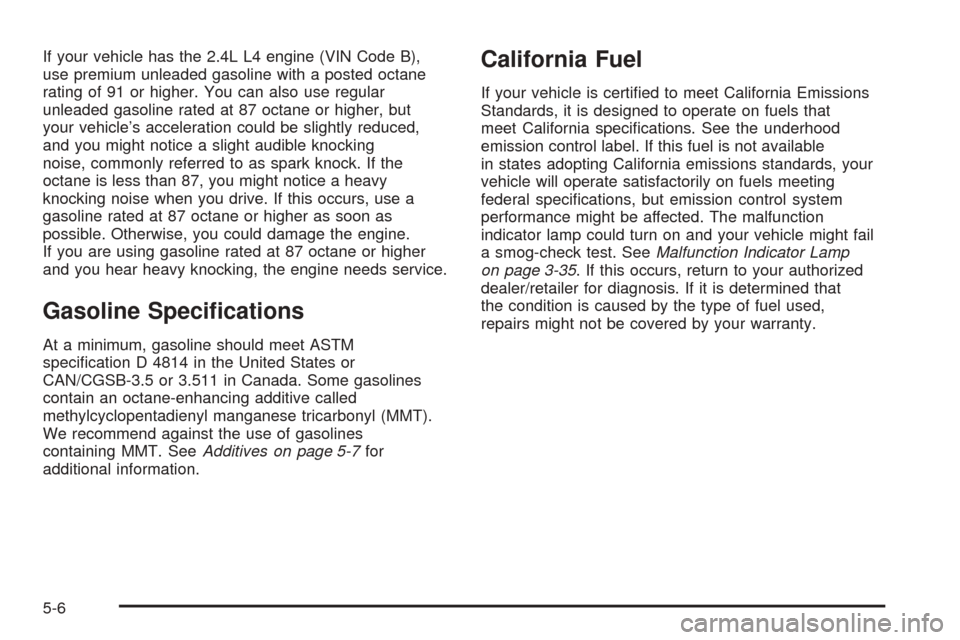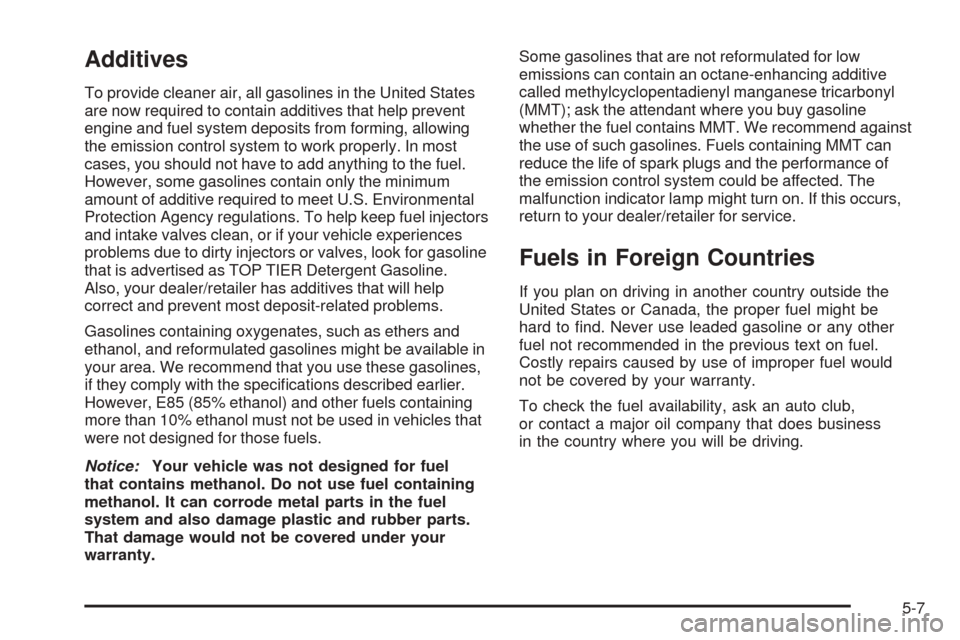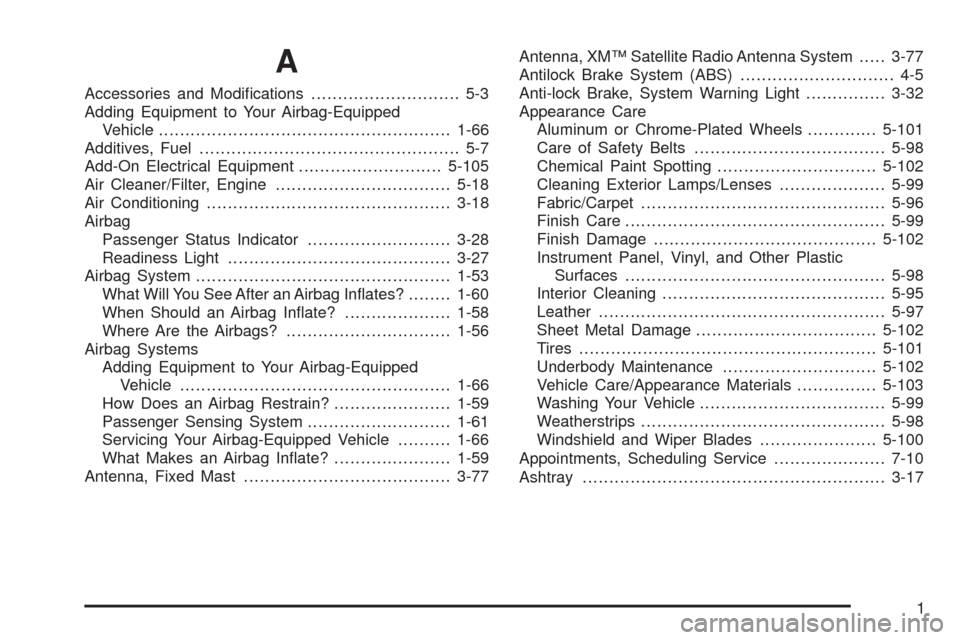service indicator CHEVROLET COBALT 2008 1.G User Guide
[x] Cancel search | Manufacturer: CHEVROLET, Model Year: 2008, Model line: COBALT, Model: CHEVROLET COBALT 2008 1.GPages: 402, PDF Size: 2.15 MB
Page 206 of 402

If the ETS indicator/warning light comes on and stays
on for an extended period of time when the transmission
shift lever is in any position other than LOW (L), your
vehicle may need service.
When this light is on solid, the system will not limit
wheel spin. Adjust your driving accordingly.
Check your DIC messaging to determine whether it is
because of the driver turning off the system, or that the
system may not be working properly and your vehicle
requires service. When this light is turned on, either the
SERVICE TRACTION or TRACTION OFF message
will be displayed.
SeeDIC Warnings and Messages on page 3-43for
more information on the messages associated with
this light.
To limit wheel spin, especially in slippery road
conditions, you should always leave the ETS on.
But you can turn the system off if you prefer.
To turn the system off, shift to LOW (L) or
REVERSE (R).
When you turn the system off, the ETS indicator/warning
light will come on and stay on and TRACTION OFF
message will be displayed when the gear shift is
in LOW (L). The indicator/warning light and message
will not come on when the gear shift is in REVERSE (R).
If the ETS is limiting wheel spin when you shift to
LOW (L) or REVERSE (R) to turn the system off, theindicator/warning light and TRACTION OFF will come
on in LOW (L). But the system won’t turn off right away.
It will wait until there’s no longer a current need to
limit wheel spin.
SeeDIC Warnings and Messages on page 3-43for
more information on the messages associated with
this light.
You can turn the system back on at any time by
shifting to AUTOMATIC OVERDRIVE (D) or
INTERMEDIATE (I). The ETS indicator/warning light
should go off.
Adding non-dealer/non-retailer accessories can affect
your vehicle’s performance. SeeAccessories and
Modifications on page 5-3for more information.
Electronic Stability Control (ESC)
Your vehicle may have an Electronic Stability Control
(ESC) system which combines antilock brake, and
traction and stability control systems that help the driver
maintain directional control of the vehicle in most
driving conditions.
When the vehicle is started and begins to move, the
system performs several diagnostic checks to ensure
there are no problems. You may hear or feel the system
working. This is normal and does not mean there is a
problem with your vehicle. The system should initialize
before the vehicle reaches 20 mph (32 km/h).
4-10
Page 207 of 402

If the system fails to turn on or activate, the ESC/TCS
light comes on, and the ESC OFF and/or SERVICE ESC
message displays.
For more information, seeDriver Information Center
(DIC) on page 3-40andElectronic Stability Control
(ESC)/Traction Control System (TCS) Indicator/Warning
Light on page 3-33.
This light �ashes on the
instrument panel cluster
when the ESC system
is on and activated.
ESC activates when the computer senses a discrepancy
between your intended path and the direction the
vehicle is actually travelling. ESC selectively applies
braking pressure at any one of the vehicle’s brakes to
help steer the vehicle in the direction which you are
steering.
When the system activates, an ESC ACTIVE
message displays on the Driver Information Center.
SeeDIC Warnings and Messages on page 3-43.This light also �ashes on the instrument panel
cluster when the ESC system is on and activated.
You may also hear a noise or feel vibration in the brake
pedal. This is normal. Continue to steer the vehicle in
the direction you want it to go.
When the light is on solid and the message(s),
SERVICE ESC, ESC OFF, or both display, the system
will not assist the driver in maintaining directional
control of the vehicle. Adjust your driving accordingly.
SeeDIC Warnings and Messages on page 3-43.
The Electronic Stability Control (ESC) system is
automatically enabled whenever you start your vehicle.
To assist the driver with vehicle directional control,
especially in slippery road conditions, you should always
leave the system on. But, you can turn ESC off if you
ever need to.
If the vehicle is in cruise control when the system
begins to assist the driver maintain directional control of
the vehicle, the ESC/TCS light will �ash and the
cruise control will automatically disengage. When road
conditions allow you to use cruise again, you may
re-engage the cruise control. SeeCruise Control on
page 3-10.
4-11
Page 244 of 402

If your vehicle has the 2.4L L4 engine (VIN Code B),
use premium unleaded gasoline with a posted octane
rating of 91 or higher. You can also use regular
unleaded gasoline rated at 87 octane or higher, but
your vehicle’s acceleration could be slightly reduced,
and you might notice a slight audible knocking
noise, commonly referred to as spark knock. If the
octane is less than 87, you might notice a heavy
knocking noise when you drive. If this occurs, use a
gasoline rated at 87 octane or higher as soon as
possible. Otherwise, you could damage the engine.
If you are using gasoline rated at 87 octane or higher
and you hear heavy knocking, the engine needs service.
Gasoline Speci�cations
At a minimum, gasoline should meet ASTM
speci�cation D 4814 in the United States or
CAN/CGSB-3.5 or 3.511 in Canada. Some gasolines
contain an octane-enhancing additive called
methylcyclopentadienyl manganese tricarbonyl (MMT).
We recommend against the use of gasolines
containing MMT. SeeAdditives on page 5-7for
additional information.
California Fuel
If your vehicle is certi�ed to meet California Emissions
Standards, it is designed to operate on fuels that
meet California speci�cations. See the underhood
emission control label. If this fuel is not available
in states adopting California emissions standards, your
vehicle will operate satisfactorily on fuels meeting
federal speci�cations, but emission control system
performance might be affected. The malfunction
indicator lamp could turn on and your vehicle might fail
a smog-check test. SeeMalfunction Indicator Lamp
on page 3-35. If this occurs, return to your authorized
dealer/retailer for diagnosis. If it is determined that
the condition is caused by the type of fuel used,
repairs might not be covered by your warranty.
5-6
Page 245 of 402

Additives
To provide cleaner air, all gasolines in the United States
are now required to contain additives that help prevent
engine and fuel system deposits from forming, allowing
the emission control system to work properly. In most
cases, you should not have to add anything to the fuel.
However, some gasolines contain only the minimum
amount of additive required to meet U.S. Environmental
Protection Agency regulations. To help keep fuel injectors
and intake valves clean, or if your vehicle experiences
problems due to dirty injectors or valves, look for gasoline
that is advertised as TOP TIER Detergent Gasoline.
Also, your dealer/retailer has additives that will help
correct and prevent most deposit-related problems.
Gasolines containing oxygenates, such as ethers and
ethanol, and reformulated gasolines might be available in
your area. We recommend that you use these gasolines,
if they comply with the speci�cations described earlier.
However, E85 (85% ethanol) and other fuels containing
more than 10% ethanol must not be used in vehicles that
were not designed for those fuels.
Notice:Your vehicle was not designed for fuel
that contains methanol. Do not use fuel containing
methanol. It can corrode metal parts in the fuel
system and also damage plastic and rubber parts.
That damage would not be covered under your
warranty.Some gasolines that are not reformulated for low
emissions can contain an octane-enhancing additive
called methylcyclopentadienyl manganese tricarbonyl
(MMT); ask the attendant where you buy gasoline
whether the fuel contains MMT. We recommend against
the use of such gasolines. Fuels containing MMT can
reduce the life of spark plugs and the performance of
the emission control system could be affected. The
malfunction indicator lamp might turn on. If this occurs,
return to your dealer/retailer for service.
Fuels in Foreign Countries
If you plan on driving in another country outside the
United States or Canada, the proper fuel might be
hard to �nd. Never use leaded gasoline or any other
fuel not recommended in the previous text on fuel.
Costly repairs caused by use of improper fuel would
not be covered by your warranty.
To check the fuel availability, ask an auto club,
or contact a major oil company that does business
in the country where you will be driving.
5-7
Page 271 of 402

{CAUTION:
The brake wear warning sound means that soon
the brakes will not work well. That could lead to
an accident. When you hear the brake wear
warning sound, have your vehicle serviced.
Notice:Continuing to drive with worn-out brake
pads could result in costly brake repair.
Some driving conditions or climates can cause a brake
squeal when the brakes are �rst applied or lightly
applied. This does not mean something is wrong with
the brakes.
Properly torqued wheel nuts are necessary to help
prevent brake pulsation. When tires are rotated, inspect
brake pads for wear and evenly tighten wheel nuts in
the proper sequence to torque speci�cations in
Capacities and Specifications on page 5-112.
If your vehicle has rear drum brakes, they do not have
wear indicators, but if you ever hear a rear brake
rubbing noise, have the rear brake linings inspected
immediately. Also, the rear brake drums shouldbe removed and inspected each time the tires are
removed for rotation or changing. When you have
the front brake pads replaced, have the rear brakes
inspected, too.
Brake linings should always be replaced as complete
axle sets.
Brake Pedal Travel
See your dealer/retailer if the brake pedal does not
return to normal height, or if there is a rapid increase in
pedal travel. This could be a sign that brake service
might be required.
Brake Adjustment
Every time you make a moderate brake stop, the disc
brakes adjust for wear. If you rarely make a moderate or
heavier stop, then the brakes might not adjust correctly.
If you drive in that way, then — very carefully — make
a few moderate brake stops about every 1,000 miles
(1 600 km), so the brakes will adjust properly.
If your vehicle has rear drum brakes and the brake
pedal goes down farther than normal, the rear drum
brakes might need adjustment. Adjust them by backing
up and �rmly applying the brakes a few times.
5-33
Page 296 of 402

Please note that the TPMS is not a substitute for proper
tire maintenance, and it is the driver’s responsibility to
maintain correct tire pressure, even if under-in�ation
has not reached the level to trigger illumination of
the TPMS low tire pressure telltale.
Your vehicle has also been equipped with a TPMS
malfunction indicator to indicate when the system is
not operating properly. The TPMS malfunction indicator
is combined with the low tire pressure telltale. When
the system detects a malfunction, the telltale will
�ash for approximately one minute and then remain
continuously illuminated. This sequence will continue
upon subsequent vehicle start-ups as long as the
malfunction exists.
When the malfunction indicator is illuminated, the
system may not be able to detect or signal low tire
pressure as intended. TPMS malfunctions may occur
for a variety of reasons, including the installation
of replacement or alternate tires or wheels on the vehicle
that prevent the TPMS from functioning properly.
Always check the TPMS malfunction telltale after
replacing one or more tires or wheels on your vehicle
to ensure that the replacement or alternate tires
and wheels allow the TPMS to continue to function
properly.
SeeTire Pressure Monitor Operation on page 5-59for
additional information.Federal Communications
Commission (FCC) and Industry
and Science Canada
The Tire Pressure Monitor System (TPMS) operates
on a radio frequency and complies with Part 15 of
the FCC Rules. Operation is subject to the following
two conditions:
1. This device may not cause harmful interference.
2. This device must accept any interference received,
including interference that may cause undesired
operation.
The Tire Pressure Monitor System (TPMS) operates
on a radio frequency and complies with RSS-210
of Industry and Science Canada. Operation is subject
to the following two conditions:
1. This device may not cause interference.
2. This device must accept any interference received,
including interference that may cause undesired
operation of the device.
Changes or modi�cations to this system by other than
an authorized service facility could void authorization
to use this equipment.
5-58
Page 389 of 402

A
Accessories and Modi�cations............................ 5-3
Adding Equipment to Your Airbag-Equipped
Vehicle.......................................................1-66
Additives, Fuel................................................. 5-7
Add-On Electrical Equipment...........................5-105
Air Cleaner/Filter, Engine.................................5-18
Air Conditioning..............................................3-18
Airbag
Passenger Status Indicator...........................3-28
Readiness Light..........................................3-27
Airbag System................................................1-53
What Will You See After an Airbag In�ates?........1-60
When Should an Airbag In�ate?....................1-58
Where Are the Airbags?...............................1-56
Airbag Systems
Adding Equipment to Your Airbag-Equipped
Vehicle...................................................1-66
How Does an Airbag Restrain?......................1-59
Passenger Sensing System...........................1-61
Servicing Your Airbag-Equipped Vehicle..........1-66
What Makes an Airbag In�ate?......................1-59
Antenna, Fixed Mast.......................................3-77Antenna, XM™ Satellite Radio Antenna System.....3-77
Antilock Brake System (ABS)............................. 4-5
Anti-lock Brake, System Warning Light...............3-32
Appearance Care
Aluminum or Chrome-Plated Wheels.............5-101
Care of Safety Belts....................................5-98
Chemical Paint Spotting..............................5-102
Cleaning Exterior Lamps/Lenses....................5-99
Fabric/Carpet..............................................5-96
Finish Care.................................................5-99
Finish Damage..........................................5-102
Instrument Panel, Vinyl, and Other Plastic
Surfaces.................................................5-98
Interior Cleaning..........................................5-95
Leather......................................................5-97
Sheet Metal Damage..................................5-102
Tires........................................................5-101
Underbody Maintenance.............................5-102
Vehicle Care/Appearance Materials...............5-103
Washing Your Vehicle...................................5-99
Weatherstrips..............................................5-98
Windshield and Wiper Blades......................5-100
Appointments, Scheduling Service.....................7-10
Ashtray.........................................................3-17
1
Page 393 of 402

E
Easy Entry Seat............................................... 1-8
EDR .............................................................7-17
Electrical System
Add-On Equipment.....................................5-105
Engine Compartment Fuse Block.................5-108
Floor Console Fuse Block...........................5-106
Fuses and Circuit Breakers.........................5-106
Headlamp Wiring.......................................5-105
Power Windows and Other Power Options.......5-105
Windshield Wiper Fuses.............................5-105
Electronic Stability Control................................4-10
Electronic Stability Control Indicator Light...........3-33
Engine
Air Cleaner/Filter.........................................5-18
Check and Service Engine Soon Light............3-35
Coolant......................................................5-20
Coolant Heater............................................2-27
Coolant Temperature Warning Light................3-34
Drive Belt Routing.......................................6-15
Engine Compartment Overview......................5-12
Exhaust.....................................................2-36
Oil .............................................................5-13
Oil Life System...........................................5-16
Overheating................................................5-23
Starting......................................................2-25Enhanced Traction System (ETS)........................ 4-9
Indicator/Warning Light.................................3-32
Entry/Exit Lighting...........................................3-15
Event Data Recorders.....................................7-17
Extender, Safety Belt.......................................1-29
F
Filter
Engine Air Cleaner......................................5-18
Finish Damage.............................................5-102
Fixed Mast Antenna........................................3-77
Flashers, Hazard Warning.................................. 3-6
Flash-to-Pass................................................... 3-8
Flat Tire........................................................5-73
Flat Tire, Changing.........................................5-74
Flat Tire, Storing.............................................5-93
Fluid.............................................................5-20
Automatic Transmission................................5-19
Windshield Washer......................................5-30
Fog Lamp
Fog ...........................................................3-14
Fog Lamp Light..............................................3-39
Folding Rear Seat............................................ 1-9
5
Page 396 of 402

Lighting
Entry/Exit...................................................3-15
Lights............................................................3-12
Flash-to-Pass............................................... 3-8
High/Low Beam Changer................................ 3-8
On Reminder..............................................3-13
Loading Your Vehicle.......................................4-27
Lockout Protection..........................................2-13
Locks
Automatic Door Lock....................................2-11
Delayed Locking..........................................2-11
Door..........................................................2-10
Lockout Protection.......................................2-13
Power Door................................................2-10
Programmable Automatic Door Unlock............2-11
Rear Door Security Locks.............................2-12
Loss of Control...............................................4-15
Lumbar
Manual Controls............................................ 1-3
M
Maintenance Schedule
Additional Required Services........................... 6-6
At Each Fuel Fill........................................... 6-8
At Least Once a Month.................................. 6-9Maintenance Schedule (cont.)
At Least Once a Year.................................... 6-9
Introduction.................................................. 6-2
Maintenance Footnotes.................................. 6-7
Maintenance Record....................................6-16
Maintenance Replacement Parts....................6-14
Maintenance Requirements............................. 6-2
Owner Checks and Services........................... 6-8
Recommended Fluids and Lubricants.............6-12
Scheduled Maintenance................................. 6-4
Using.......................................................... 6-2
Your Vehicle and the Environment................... 6-2
Malfunction Indicator Light................................3-35
Manual Lumbar Controls.................................... 1-3
Manual Seats................................................... 1-2
Manual Transmission
Fluid..........................................................5-20
Operation...................................................2-30
Manual, Using.................................................... iii
Manual Windows............................................2-15
Message
DIC Warnings and Messages........................3-43
Mirror Reading Lamps.....................................3-15
Mirrors
Manual Rearview Mirror................................2-38
Manual Rearview Mirror with OnStar
®.............2-38
Outside Convex Mirror.................................2-39
8
Page 397 of 402

Mirrors (cont.)
Outside Manual Mirror..................................2-38
Outside Power Mirrors..................................2-39
Outside Remote Control Mirror......................2-38
MP3 .............................................................3-69
MyGMLink.com................................................ 7-4
N
Navigation System, Privacy..............................7-18
New Vehicle Break-In......................................2-21
O
Odometer......................................................3-25
Off-Road Recovery..........................................4-15
Oil
Engine.......................................................5-13
Pressure Light.............................................3-38
Oil, Engine Oil Life System..............................5-16
Older Children, Restraints................................1-30
Online Owner Center........................................ 7-4
OnStar, Privacy..............................................7-18
OnStar
®System, see OnStar®Manual...............2-40
Other Warning Devices...................................... 3-6Outlet Adjustment............................................3-21
Outlets
Accessory Power.........................................3-16
Outside
Convex Mirror.............................................2-39
Manual Mirror.............................................2-38
Power Mirrors.............................................2-39
Remote Control Mirror..................................2-38
Owner Checks and Services.............................. 6-8
Owners, Canadian............................................... ii
P
Paint, Damage..............................................5-102
Park Brake....................................................2-32
Park (P)
Shifting Into................................................2-33
Shifting Out of............................................2-35
Parking
Over Things That Burn.................................2-36
Parking Your Vehicle.......................................2-35
Passenger Airbag Status Indicator.....................3-28
Passenger Compartment Air Filter.....................3-21
Passenger Sensing System..............................1-61
Passing.........................................................4-15
9